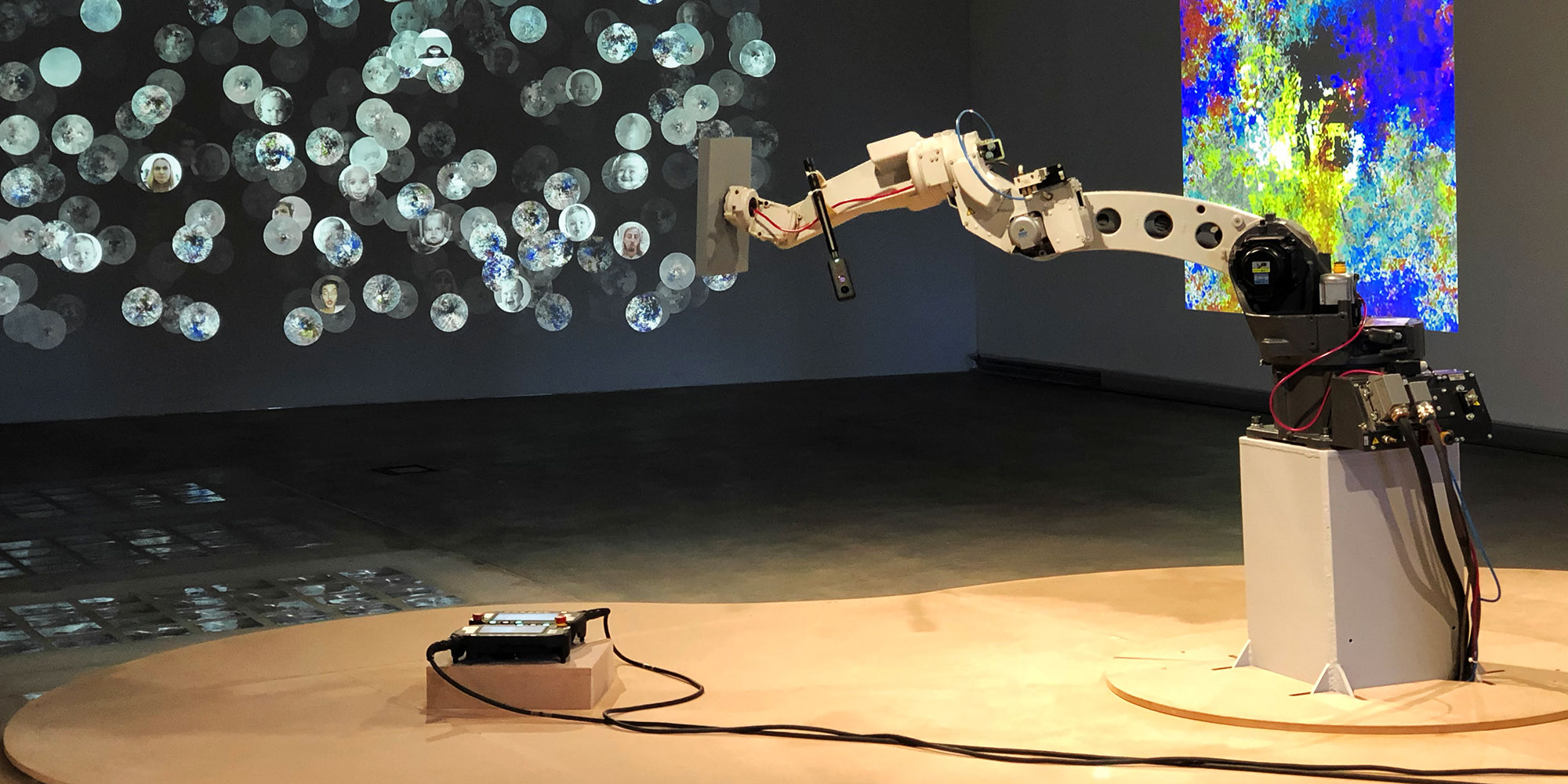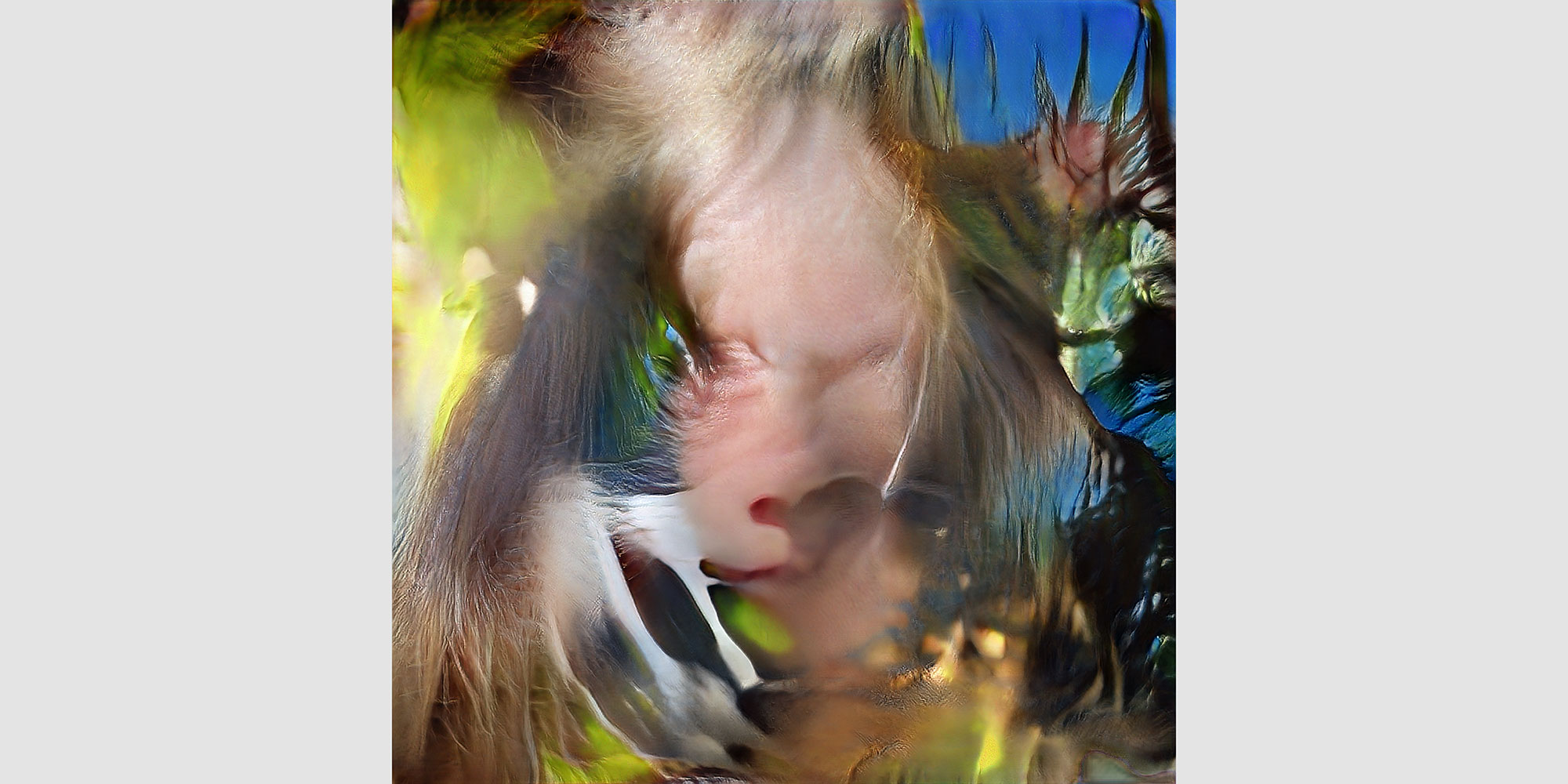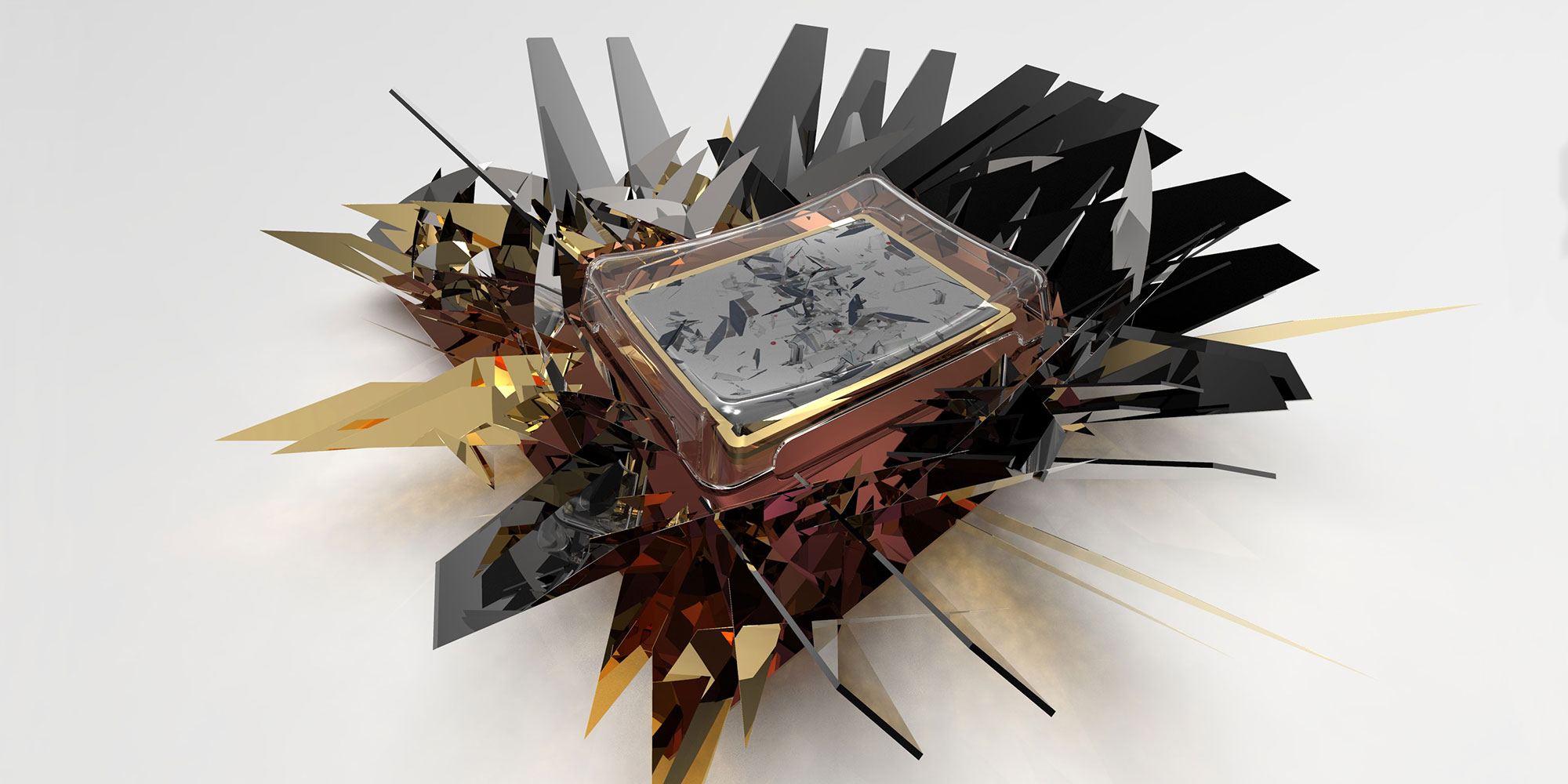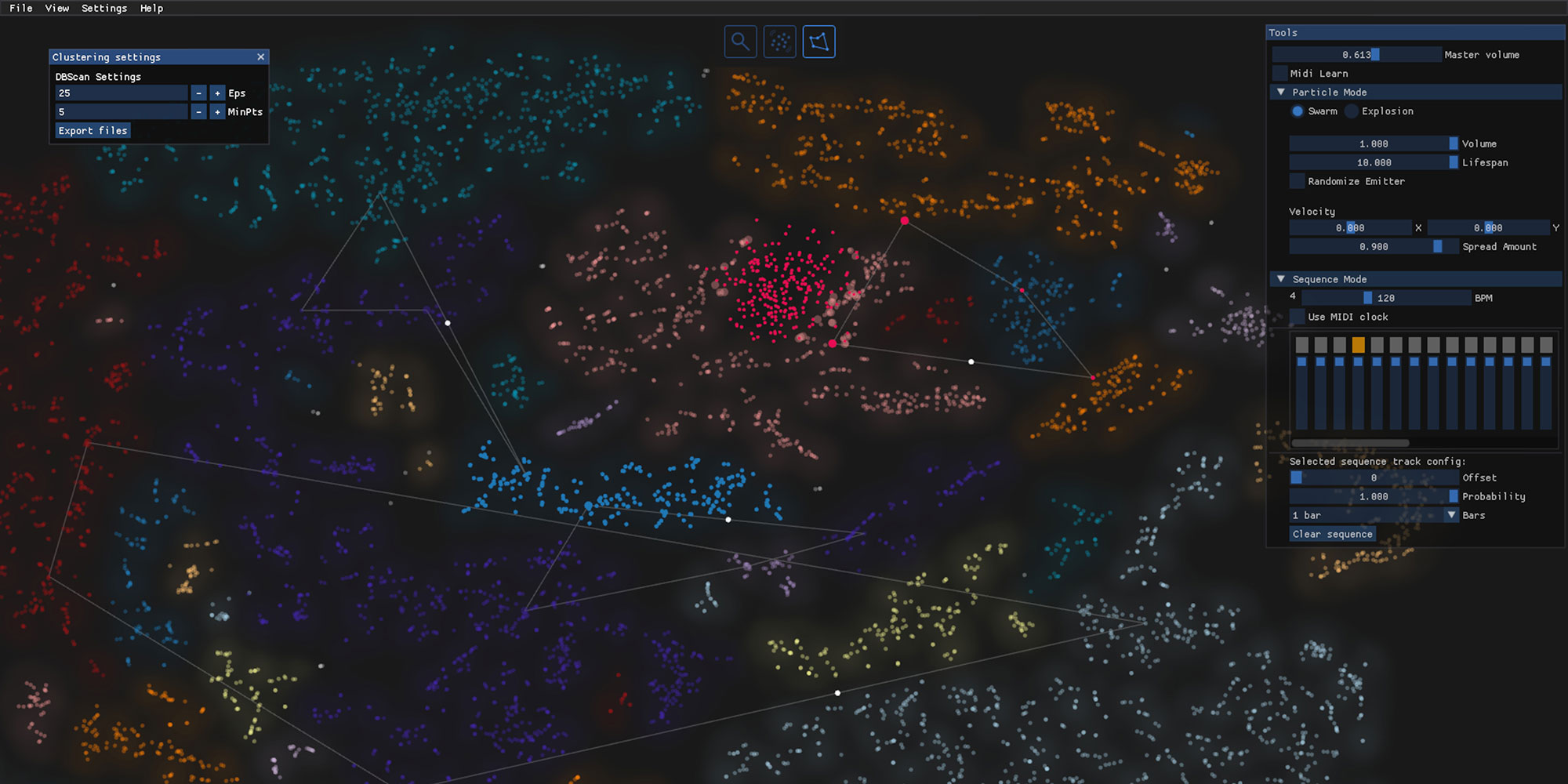The Garden of Curiosity is a “visual and sound objects” web support scenario. By clicking on specific objects, visitors can access audiovisual content corresponding to different Art-Science research projects linked to Muntref Arte y Ciencia. Among the transdisciplinary works that can be explored are:
Mariano Sardón (AR), Mariano Sigman (AR/ES)
DEEP UN.LEARNING
Interactive robotic installation
Two robotic arms ask people to mimic baby gestures and take images of their faces, which they tehn feed to an AI system. The system stores the gestures as a kind of an elementary communication atlas. An algorithm learns what is most gesturally relevant to us at the beginning of our lives.
Credits:
Project Coordination: Germán Ito
Algorithms: Sabrina García
Robotics: Ignacio Fourmentel, Joaquín Bua Bonaldi (Patagonia CNC Machines)
Mariano Sardón (AR), Mariano Sigman (AR/ES), Marcos Trevisán (AR)
THE NEUROSCIENCE OF LAUGHTER
A research project on sound and neuroscience. We are looking for a sound basis for the laugh expression. What kind of sound characteristics trigger our laugh? And why is laughter so contagious?
Credits:
Project Coordination: Germán Ito
Sound: Juan Cruz Oblander, Rocío Traviglia
Mariano Sardón (AR), Mariano Sigman (AR/ES)
HOUSE OF PORTRAITS
Video installation
Several screens exhibit a sequence of people performing iconic gestures in extremely slow motion. Neuroscientists consider we produce tiny microgestures during facial communication movement. With a high speed camera, a series of universal gestures -like sadness, anger, disgust, happiness, and astonishment- were recorded.
Credits:
Project coordination: Germán Ito
Camera and postproduction: Cecilia Cisneros, Lucía Carvallo, Lautaro Sardelli, Amilcar Malatesta
Mariano Sardón (AR), in collaboration with Mariano Sigman (AR/ES) and Bruno Mesz (AR)
CONDUCTED BY THE EYES
Vision tracking performance
A music director studies the score of Beethoven’s Nº 12 opus 127 string quartet. An eyetracker device allows spectators and musicians to see where the director’s eyes rest on the score during his reading in real time. The musicians follow and plays the score through the director’s gaze.
Credits:
Musicians: Bruno Mesz, Guido Kohn
Technical coordination by: German Ito
Software: Nahuel Rodrigues, Santiago Terigi
Mariano Sardón (AR), Mariano Sigman (AR/ES)
MORPHOLOGY OF GAZES
Generative video installation
Portraits of immigrants are revealed through the eye movements of about 40 people. Eye gestures were recorded by an eye tracker device. In the video, all the gazes are reproduced at once.
Credits:
Project coordination: Germán Ito
Camera: Cecilia Cisneros, Lucía Carvallo
Eye tracker: Nahuel Rodrigues
Mariano Sardón (AR), Mariano Sigman (AR/ES)
READ UNREAD
Series of laser cut books. George Bataille’s erotic Story of the Eye, Isaac Newton’s De motu corporum in gyrum, Galileo Galilei’s “Sidereus nuncius” and the anonymous Thérèse Philosophe, were split in two. One of the books contains those parts of the text that were relevant to the cognition process during reading. The other is what the eyes of the reader neglected during reading. Significant parts of the text are picked up by using an eye tracker device.
Credits:
Project coordination: Germán Ito
Intercambios Transorgánicos (AR)
C3D
Rehabilitation interactive interface
The C3D is an interactive interface we designed for physical rehabilitation treatments. We started by inquiring about patient motivation, and how art and technology could collaborate with a new approach to rehabilitation: instead of repeating movements, patients could always create new movements inspired by their identities and desire. This interface has a physical and web version that has been designed to collaborate with COVID19 pandemic impact via telemedicine treatments.
Credits:
Project coordination: Gala Gonzalez
Electronics: Máximo Signiorini
Physical and web: Máximo Signiorini, Manuel Biderman
Therapeutic strategy: Camila Godoy
Sebastian Tedesco (AR), Bruno Mesz (AR)
EMOTIONAL PLATES
Installation
An installation that includes videos, sounds, images and scents. It is inspired by the conceptual design of tableware that explores the use of digital devices at the table, based on the results of a cognitive pre-test on cross-modal correspondences generated by musical emotions, and aimed at creating multisensory gastronomic atmospheres.
Credits:
Research Team: Leonardo Potenza, Camilo Álvarez
Bruno Mesz (AR) and Sebastián Tedesco (AR)
UNDOCUMENTED EMOTIONS: AESTHETICIZED CAPITALISM
Installation
At the installation, the public can choose between two vibro-tactile-aromatic abstract compositions and experience the selected one by leaning their backs on transducers that produce tactile sensations, accompanied by an aroma facilitated by an operator. Scents are interpretations and / or olfactory translations of the concepts of “money” and “pollution”.
Credits:
Research Team: Leonardo Potenza, Camilo Álvarez
Aromas: IFF (International Flavors & Fragrances)
Sebastián Tedesco (AR), Bruno Mesz (AR)
EMANATIONS OF DISCOURSE
Cross-modal video installation
The installation focuses on a cross-modal artistic intervention based on proclamations by two iconic activists: Martin Luther King and Greta Thunberg. The discourses create a universe of relationships based on a primary layer of senses (sight and sound). At the same time, they open up to other senses that are not as obvious, but capable of completing the discursive universe or diverting their logic. It is precisely here, where certain sensory modalities are veiled by the preeminence of the word, that this project begins.
Credits:
Research Team: Leonardo Potenza, Camilo Álvarez
Aromas: IFF (International Flavors & Fragrances)
Bruno Mesz (AR), Sebastián Tedesco (AR)
PERFUME OF YUYO AND ALFALFA
Cross-modal performance
The work consists of a performance where a “smell organ” is used to execute a series of tangos that have been smell-ified in order to explore the cross-modal effects of scent on musical perception. The “smell organ” is a cross-modal system that associates piano notes with a series of spatialized scent-release devices. The selection of scents that smellify each tango arose from an investigation of the aromatic references in tango lyrics.
Credits:
Piano performance: Bruno Mesz
Research Students: Camilo Álvarez, Leonardo Potenza
Collaborators: María Zegna, Carlos Sztaynberg
Sebastian Tedesco (AR), Bruno Mesz (AR)
EVASION PLAN
Object
The work explores possible relations of conceptual and olfactory compatibility between the parts of a written universe. It hypothesizes that it is possible to extract, from a text and a series of selections and editing operations analogous to chemical distillation and re-synthesis processes, a condensed scent of the sublimated text in aromatic. The text is Adolfo Bioy Casares’ Evasion Plan, where synesthesia is one of the central themes. The piece consists of a large green glass jar, from whose interior the novel’s perfume emerges. The liquid inside the bottle contains a scent and sound release device that reproduces aromatic references dispersed within the text, to converge in a single perfume due to its spatial proximity. From that point, a weak voice arises (it is necessary to physically approach it to perceive it) that narrates fragments of the book.
Credits:
Research Team: Leonardo Potenza, Camilo Álvarez
Bruno Mesz (AR), Sebastián Tedesco (AR)
BEYOND INTIMACY
Cross-modal performance
This is a performance where cross-modal glasses are used for the participants to experience the cross-modal effects of sound-taste in wine. The “cross-modal glass” is an interactive cup that has capacitive sensors and an accelerometer, which detect specific movements and actions such as the act of drinking, aeration the cup, tilting, etc. The data collected by the sensors is sent wirelessly to a system that uses them to trigger sounds or activate various actuators. The device was developed to be used in performances and scientific experiments that explore cross-modal associations (correspondences between the senses). Through these, sound, visual, tactile or olfactory stimuli can modify the sense of taste, as has been demonstrated in numerous publications of empirical psychology.
Credits:
Collaboration: Juan Cruz Amusategui
Bruno Mesz (AR)
TASTE OF MUSIC
Installation
Four buttons trigger music related to the four basic tastes: bitter, sweet, sour and salty. Based on the The Taste of Music, a paper by Bruno Mesz, Marcos Trevisán and Mariano Sigman. Presented at the Cooper Hewitt Smithsonian Design Museum, NYC, as part of the The Senses: Design Beyond Vision.
Leandro Garber (AR), Tomás Ciccola (AR)
AUDIOSTELLAR
AudioStellar is a sampler-like musical instrument for latent sound structure discovery and experimentation. It processes a user-selected folder containing audio files and generates an intelligent soundmap by placing each audio file as a point in 2D space. Nearby points correspond to spectrally similar sounds (i.e similar timbre), while far away points are dissimilar. This allows the sound artist to explore a sound library or field recording aided by machine intelligence that reveals a latent structure present in the input sound files. AudioStellar features multiple modes to allow novel composition and sound design workflows.
Lucía Kuschnir (AR), Josefina Schmipp (AR), Viviana Ramos Di Tommaso (AR), Diego De Benedetto (AR) – Maximiliano Perez (AR)
ARCHEOLOGY
By Photographic series of 10 devices used in a biology laboratory. The portraits, made in large-scale Fine Art printing, pay homage to them.
Lucía Kuschnir (AR), Josefina Schmipp (AR), Viviana Ramos Di Tommaso (AR), Diego De Benedetto (AR), Maximiliano Perez (AR)
TREATISE
Inventory of daily used instruments in a laboratory with museographic purposes. Photographs were taken from the researcher’s point of view, in 10 x 10 cm. backligth boxes.
Lucía Kuschnir (AR), Josefina Schmipp (AR), Viviana Ramos Di Tommaso (AR), Diego De Benedetto (AR)
MINIMAL LANDSCAPES
Low-budget microtome manufacturing and edition of microphotographs and microvideos made with the ultra-thin cuts of histological samples.






